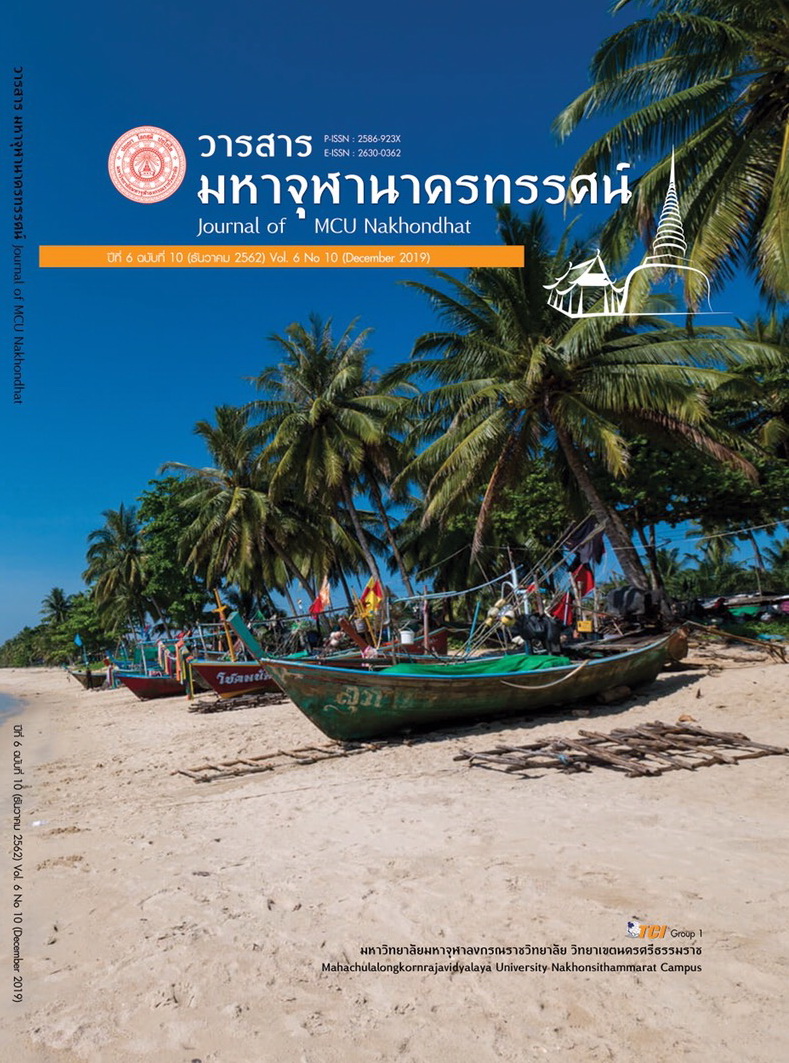THE ANTECEDENTS OF INTENTION TO SUPPORTED THAI’S PRODUCTS OF VIETNAMESE CONSUMERS AND CAMBODIAN CONSUMERS
Main Article Content
Abstract
The objectives of this research were to study the influences of brand equity, country of origin image, marketing stimuli, and national pride on the intention to support Thai goods. This research employed a quantitative method. The sample consisted of 400 consumers in Vietnam and Cambodia who had the experience of using goods originating from Thailand, obtained by multi-stage sampling. The size of the sample was determined based on the criterion of 20 times the observed variables. Data were collected with the use of a questionnaire and analyzed with a structural equation model.
The research findings:
Showed that marketing stimuli had the highest overall influence on the intention to support Thai goods among consumers in the Vietnam and Cambodia countries, followed by brand equity, national pride, and country of origin image, respectively. These research findings can serve as guidelines for Thai investors to manage their export businesses and marketing strategies as well as to communicate effectively in order to enhance the image and value of their products, organizational brands, and Thailand as s whole. This represents an important step to promote the intention to support Thai products among consumers in Vietnam and Cambodia countries. Moreover, the Ministry of Commerce can use these findings in planning and determining policies to promote the intention to support Thai products among consumers in the ASEAN region, especially those from Vietnam and Cambodia, who serve as important markets for Thai entrepreneurs.
Article Details
References
กรมส่งเสริมการค้าระหว่างประเทศ. (2558). ประเทศกัมพูชา. เรียกใช้เมื่อ 10 พฤศจิกายน 2560 จาก http://www.ditp.go.th/contents_attach/ 169851/169851.pdf
ฐานเศรษฐกิจ. (2560). Deepening CLMV Urbanization เจาะลึกศักยภาพ 4 เมืองใหม่ เตรียมพร้อมสู่การลงทุนเต็มรูปแบบ. เรียกใช้เมื่อ 10 พฤศจิกายน 2560 จาก http://www.thansettakij.com/content/131904
พิชญ์สินี ฐิติสมบูรณ์. (2558). ส่องโอกาส วางกลยุทธ์เจาะตลาด CLMV. เรียกใช้เมื่อ 10 พฤศจิกายน 2560 จาก https://www.scbeic.com/th/detail/ product/1480
Abril C. & Rodriguez-Cánovas B. (2016). Marketing mix effects on private labels brand equity. European Journal of Management and Business Economics, 25(3), 168-175.
Ahmed S. N. B. & Judhi N. (2010). Organic food: A study on demographic characteristics and factors influencing purchase intentions among consumers in Klang Valley. International Journal of Business and Management, 5(2), 105-118.
Bee Lian S. et al.. (2016). The Effects of Marketing Stimuli Factors on Consumers’ Perceived Value and Purchase of Organic Food in Malaysia. Jurnal Pengurusan (UKM Journal of Management), 47(1), 119-130.
Kapferer J. N. (2012). The new strategic brand management: Advanced insights and strategic thinking. London United Kingdom: Kogan page publishers.
Kline R. B. (2005). Principle and practice of structural equation modeling. New York: Guilford.
Kock N. & Hadaya P. (2018). Minimum sample size estimation in PLS-SEM: The inverse square root and gamma-exponential methods. Information Systems Journal, 28(1), 227-261.
Lee D. & Ganesh G. (1999). Effects of partitioned country image in the context of brand image and familiarity: A categorization theory perspective. International Marketing Review, 16(1), 18-41.
Orbaiz L. V. & Papadopoulos N. (2003). Toward a model of consumer receptivity of foreign and domestic products. Journal of International Consumer Marketing, 15(3), 101-126.
Shimp T. A. & Sharma S. . (1987). Consumer ethnocentrism: Construction and validation of the CETSCALE. Journal of marketing research, 24(3), 280-289.
Tasurru H. H. & Salehudin I. (2014). Global brands and consumer ethnocentrism of youth soft drink consumers in Greater Jakarta. ASEAN marketing journal, 4(2), 77-88.
Tulipa D. & Muljani N. (2015). The country of origin and brand image effect on purchase intention of smartphone in Surabaya-Indonesia. Mediterranean Journal of Social Sciences, 6(5), 64-70.
Zhen J. S. & Mansori S. (2012). Young female motivations for purchase of organic food in Malaysia. International Journal of Contemporary Business Studies, 3(5), 61-72.


